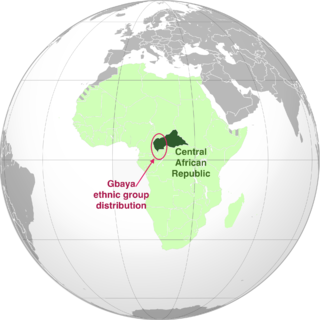Related Research Articles
The Gbaya languages, also known as Gbaya–Manza–Ngbaka, are a family of perhaps a dozen languages spoken mainly in the western Central African Republic and across the border in Cameroon, with one language (Ngbaka) in the Democratic Republic of the Congo, and several languages with few speakers in the Republic of the Congo. Many of the languages go by the ethnic name Gbaya, though the largest, with over a million speakers, is called Ngbaka, a name shared with the Ngbaka languages of the Ubangian family.

The Gbaya, also Gbeya or Baya, are a people of western region of Central African Republic, east-central Cameroon, the north of the Republic of Congo, and the northwest of the Democratic Republic of Congo. In the first half of the 20th century, the Gbaya were involved in several revolt attempts against German and then French colonial rule.
The Zande languages are half a dozen closely related languages of the Central African Republic, the Democratic Republic of the Congo, and South Sudan. The most populous language is Zande proper, with over a million speakers.
Kako is a Bantu language spoken mainly in Cameroon, with some speakers in the Central African Republic and the Republic of the Congo. The main population centres of Kako speakers are Batouri and Ndélélé in the East Region of Cameroon.
The Ubangian languages form a diverse linkage of some seventy languages centered on the Central African Republic. They are the predominant languages of the CAR, spoken by 2–3 million people, and include the national language, Sango. They are also spoken in Cameroon, Chad, the DR Congo, the Republic of Congo and South Sudan.
Kresh, also known ambiguously as Gbaya, is a Central Sudanic language of South Sudan.
Ndogo is a Ubangian language, one of the nine major languages of South Sudan, and is taught in primary school. It is used as a secondary language by the Gollo and some of the Gbaya, among others.
Ngbaka (Ngbàkà) is a Gbaya language spoken by just over a million people in the Democratic Republic of the Congo. It is a regionally important language, used by the Gilima, Ngbundu, Mbandja and Mono peoples, and is taught in primary schools; 10% are literate in Ngbaka.
Kresh is a small language group of South Sudan. It is generally considered to be a branch of the Central Sudanic languages. Boyeldieu (2010) judges that this has yet to be demonstrated satisfactorily, but Starostin (2016) finds convincing evidence, and that its closest relative within that family appears to be Birri.
Northwest Gbaya is a Gbaya language spoken across a broad expanse of Cameroon and the Central African Republic. The principal variety is Kara, a name shared with several neighboring languages; Lay (Làì) is restricted to a small area north of Mbodomo, with a third between it and Toongo that is not named in Moñino (2010), but is influenced by the Gbaya languages to the south.
Bokoto is a Gbaya language of the Central African Republic.
Gbanu is a Gbaya language of the Central African Republic. The people do not consider themselves to be ethnically Gbaya.
To is an unclassified Mbum language of northern Cameroon and the Central African Republic. It is only used as a second language, as the secret male initiation language of the Gbaya.
Bomitaba (Mbomitaba) is a Bantu language of the Republic of Congo, with a couple hundred speakers in the Central African Republic.
Mbodomo is a Gbaya language of Cameroon.
Biyanda (Ɓìyàndà) and Buli (Ɓùlì) constitute a Gbaya language of the Central African Republic. Ethnologue groups them as Southwest Gbaya, but it is not clear how many of the Southwest varieties are part of the same language; Toongo and Mbodomo, for example, are not closely related, though Toongo speakers identify ethnically as Buli, and Ethnologue also lists Mbodomo as a separate language.
Toongo (Tòòngò) is a Gbaya language of the Central African Republic. Its speakers identify as ethnically Buli, but the languages, though closely related, are distinct.
Bokoto is a Gbaya language of the Central African Republic. Ethnologue reports it may be mutually intelligible with Gbaya-Bossangoa.
Gbeya is a Gbaya language of the Central African Republic. Ethnologue reports it may be mutually intelligible with Bozom.
La'bi is the esoteric ritual language of male initiation among the Gbaya Kara, the Mbum, and some Sara Laka, in the area of Touboro near where the CAR, Chad, and Cameroon meet. It has no native speakers. It is related to Mbum, with substantial loans from one or more Sara languages.
References
- ↑ Bonjo at Ethnologue (15th ed., 2005)

- 1 2 Jouni Filip Maho, 2009. New Updated Guthrie List Online
- ↑ Gordon, Raymond G., Jr. (ed.), 2005. Ethnologue: Languages of the World, Fifteenth edition. Dallas, Texas: SIL International. Online version: http://www.ethnologue.com/15.
- ↑ Eberhard, David M., Gary F. Simons, and Charles D. Fennig (eds.). 2023. Ethnologue: Languages of the World. Twenty-sixth edition. Dallas, Texas: SIL International. https://www.ethnologue.com/language/bok/
- ↑ "Bonjo". Endangered Language Project. Retrieved 26 May 2023.
- ↑ "Spoken L1 Language: Impfondo". Glottolog. Retrieved 27 May 2023.